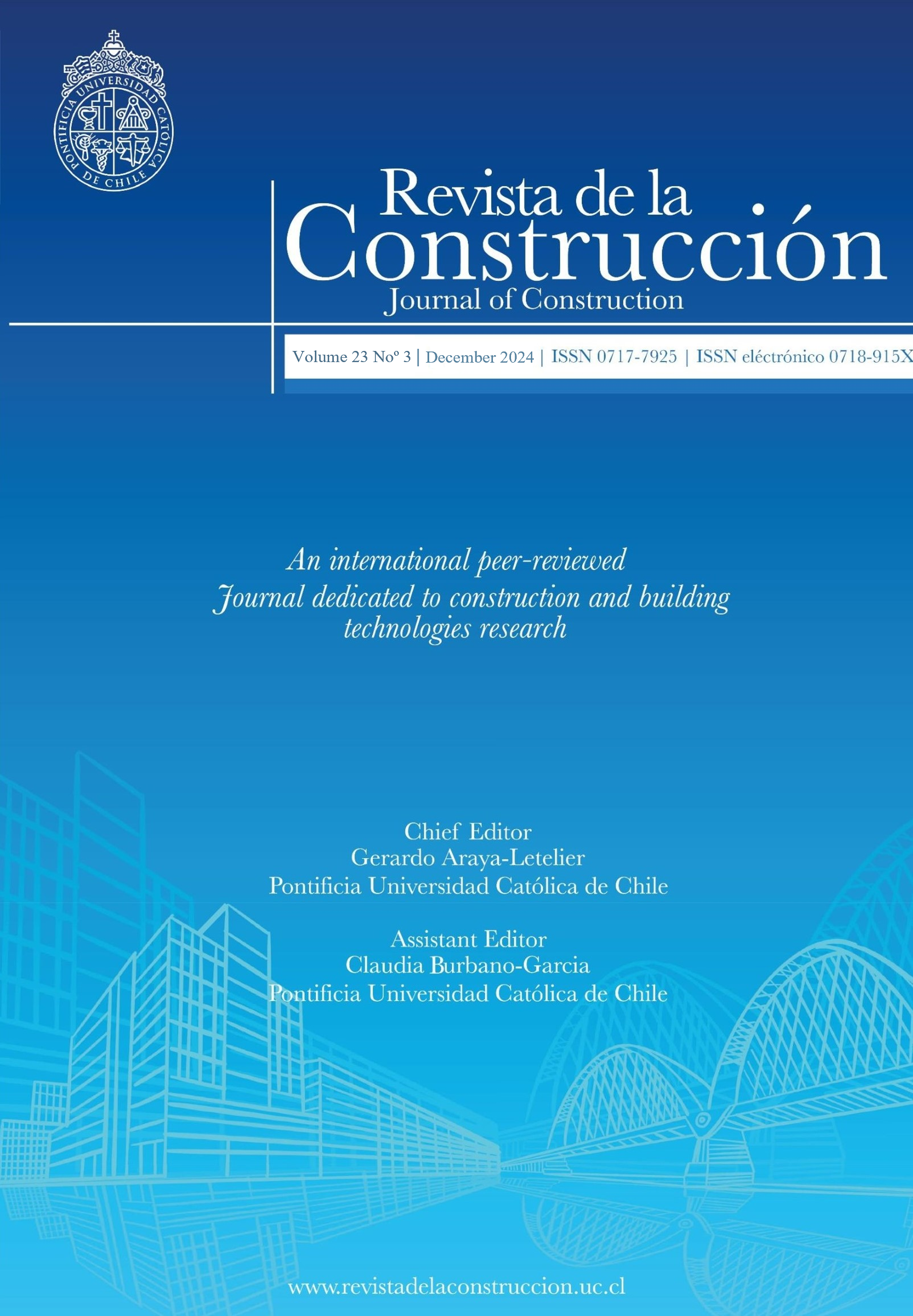Effective net area of failure in steel plates subjected to tension
DOI:
https://doi.org/10.7764/RDLC.23.3.608Keywords:
Tension Plates, Steel Plates, Effective net area, Bolted Connections, Staggered BoltsAbstract
The current design of plates in tension due to the limit state in tensile rupture according to the requirements outlined in ANSI/AISC 360 (2016) establishes that the effective net area value (Ae), must be the net area value (An), but did not be greater than 0.85 of the gross area (Ag) of the element. The research aim was to evaluate the experimental behavior of the effective net area of failure concerning 0.85Ag of steel plates subjected to tension load conduct to reliable or unsafe design. Thirty-five specimens of A36 steel with different arrangement of holes were tensile tested. Five different plates thicknesses were considered from 3.1 mm (1/8”) up to 9.5 mm (3/8”). The behavior of the effective net area of failure is discussed in term of the slenderness ratio of steel plate, the effective net area of design and analyzed based on current design specifications. The results showed that the effective net area of failure of the undrilled specimens presented a slight tendency to increase with increasing slenderness ratio. In the specimens with two rows of holes and staggered holes this tendency decreased. Whereas for the specimens with one rows of holes the effective net area of failure did not present a clear behavior with respect to slenderness ratio. Moreover, the undrilled specimens of this study developed an effective net area of failure greater than the effective net area of design, satisfying the design specifications. But in the specimens with holes the effective net area of design was greater, generating unreliable designs. In other words, the 0.85Ag value was found adequate for the specimens without holes. Nevertheless, this value was high for the specimens with holes in this experimental research.
Downloads
References
ANSI/AISC_360-16. (2016). Specification for Structural Steel Buildings. In American Institute of Steel Construction.
Barth, K. E., Orbison, J. G., and Nukala, R. (2002). Behavior of steel tension members subjected to uniaxial loading. Journal of Constructional Steel Re-search, 58, 1103–1120. www.elsevier.com/locate/jcsr
Chesson, E. J., and Munse, W. H. (1963). Riveted and Bolted Joints: Truss-Type Tensile Connections. Journal of the Structural Division, 89(1).
Di, J., Xiao, B., Li, Y., Su, Y., and Zhang, Q. (2024). Failure Modes and Bearing Capacity of High-Strength–Steel-Bearing-Type Bolted Connections. Jour-nal of Structural Engineering, 150(3). https://doi.org/10.1061/jsendh.steng-12814
Epstein, H. I., and Gulia, F. S. (1993). Finite Element Studies of Bolt Stagger Effects in Tension Members. Computers and Structures, 48(6), 1153–1156.
Fisher, J. W., Galambos, T. V., Kulak, G. L., and Ravindra, M. K. (1978). Load and Resistance Factor Design Criteria for Connectors. Journal of the Struc-tural Division, 104(9).
Hu, H., Song, W., Song, G., and Li, Y. (2023). Optimization design and parametric research of belt conveyor deck truss structure. Structures, 57. https://doi.org/10.1016/j.istruc.2023.105155
Jiang, K., Zhao, O., and Tan, K. H. (2020). Experimental and numerical study of S700 high strength steel double shear bolted connections in tension. Engineering Structures, 225. https://doi.org/10.1016/j.engstruct.2020.111175
Kamarudin, A. F., Musa, M. K., Mokhatar, S. N., Tuan Chik, T. N., Mohd Zuki, S. S., Abu Bakar, A., Hadipramana, J., and Ahmad Johari, H. H. (2020). Mechanical Properties of Single Shear Plane of Bolted Steel Connection. IOP Conference Series: Materials Science and Engineering, 713(1). https://doi.org/10.1088/1757-899X/713/1/012031
Lin, X. M., Yam, M. C. H., Chung, K. F., Ke, K., and He, Q. (2021). Experimental and numerical study on net section resistance of high strength steel staggered bolted connections. Engineering Structures, 247. https://doi.org/10.1016/j.engstruct.2021.113111
Lin, X. M., Yam, M. C. H., Chung, K. F., and Lam, A. C. C. (2021). A study of net-section resistance of high strength steel bolted connections. Thin-Walled Structures, 159. https://doi.org/10.1016/j.tws.2020.107284
Lin, X. M., Yam, M. C. H., Song, Y., Chung, K. F., Ho, H. C., and Han, Y. (2024). Net section tension capacity of high strength steel single shear bolted connections. Thin-Walled Structures, 195. https://doi.org/10.1016/j.tws.2023.111371
Liu, S., Feng, R., and Zhong, C. (2023). Shear Performance of Steel Thin Sheet-to-Thick Plate Bolted Connections. International Journal of Steel Struc-tures, 23(4), 962–973. https://doi.org/10.1007/s13296-023-00745-z
Mahmood, M., Elamin, A., and Tizani, W. (2020). Ultimate strength and fracture sequence of bolted connections to thin-walled carbon steel. Structures, 23, 646–659. https://doi.org/10.1016/j.istruc.2019.11.011
Može, P., and Beg, D. (2010). High strength steel tension splices with one or two bolts. Journal of Constructional Steel Research, 66(8–9), 1000–1010. https://doi.org/10.1016/j.jcsr.2010.03.009
Može, P., Beg, D., and Lopatič, J. (2007). Net cross-section design resistance and local ductility of elements made of high strength steel. Journal of Con-structional Steel Research, 63(11), 1431–1441. https://doi.org/10.1016/j.jcsr.2007.01.009
Nethercot, D. A., Salih, E. L., and Gardner, L. (2011). Behaviour and Design of Stainless Steel Bolted Connections. Advances in Structural Engineering, 14(4), 647–658.
NIST/SEMATECH. (2012). Engineering Handbook of Statistical Methods. National Institute of Standards and Tech-nology - U.S. Department of Com-merce, 1(1).
Peng, X., Li, X., Liu, G., and Zhao, J. (2021). Prediction of net-tension failure of multi-bolt composite joints: A fast approach for laminates with arbitrary layup. European Journal of Mechanics, A/Solids, 87. https://doi.org/10.1016/j.euromechsol.2021.104213
Santos, A. F., Santiago, A., Latour, M., Rizzano, G., and Simões da Silva, L. (2020). Response of friction joints under different velocity rates. Journal of Constructional Steel Research, 168. https://doi.org/10.1016/j.jcsr.2020.106004
Sayed, A. M. (2021). Tensile Capacity of Steel Plate Connections with Different Bolt Distribution due to Tensile Load. Journal of Engineering Science and Technology, 16(2), 888–902.
Shi, D., Huang, H., Li, N., Liu, Y., and Demartino, C. (2023). Bolted steel to laminated timber and glubam connec-tions: Axial behavior and finite-element modeling. International Journal of Mechanical Sciences, 252. https://doi.org/10.1016/j.ijmecsci.2023.108364
Teh, L. H., Asce, A. M., and Gilbert, B. P. (2011). Net Section Tension Capacity of Bolted Connections in Cold-Reduced Steel Sheets. Journal of Structural Engineering, 138(3), 337–344. https://doi.org/10.1061/(ASCE)ST.1943-541X
Teh, L. H., and Uz, M. E. (2016). Combined Bearing and Shear-Out Capacity of Structural Steel Bolted Connections. Journal of Structural Engineering, 142(11). https://doi.org/10.1061/(asce)st.1943-541x.0001573
Wang, L., and Zhu, X. (2023). Bearing Behavior of Cold-Formed Thick-Walled Steel Plates with a Single Bolt. Applied Sciences (Switzerland), 13(12). https://doi.org/10.3390/app13126897
Wang, Y. B., Lyu, Y. F., Li, G. Q., and Liew, J. Y. R. (2019). Bearing-strength of high strength steel plates in two-bolt connections. Journal of Constructional Steel Research, 155, 205–218. https://doi.org/10.1016/j.jcsr.2018.12.011
Wei, F., Fang, C., Yam, M. C. H., and Zhang, Y. (2015). Fracture behaviour and design of steel tensile connections with staggered bolt arrangements. International Journal of Steel Structures, 15(4), 863–879. https://doi.org/10.1007/s13296-015-1208-4
Zureick, A.-H., and Nassar, C. (2024). Influence of Bolt Threads on the Net Section Tensile Rupture Strength of Sin-gle-Bolt Connections in Pultruded Structures. Journal of Composites for Construction, 28(4). https://doi.org/10.1061/jccof2.cceng-4537
Downloads
Published
Versions
- 2025-01-02 (4)
- 2025-01-02 (3)
- 2025-01-02 (2)
- 2024-12-17 (1)
How to Cite
Issue
Section
License
Copyright (c) 2024 Nestor I. Prado, Julián Carrillo, Claudia Retamoso

This work is licensed under a Creative Commons Attribution-NonCommercial-NoDerivatives 4.0 International License.








